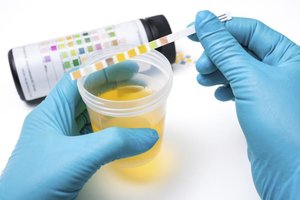- Home
- Editorial
- News
- Practice Guidelines
- Anesthesiology Guidelines
- Cancer Guidelines
- Cardiac Sciences Guidelines
- Critical Care Guidelines
- Dentistry Guidelines
- Dermatology Guidelines
- Diabetes and Endo Guidelines
- Diagnostics Guidelines
- ENT Guidelines
- Featured Practice Guidelines
- Gastroenterology Guidelines
- Geriatrics Guidelines
- Medicine Guidelines
- Nephrology Guidelines
- Neurosciences Guidelines
- Obs and Gynae Guidelines
- Ophthalmology Guidelines
- Orthopaedics Guidelines
- Paediatrics Guidelines
- Psychiatry Guidelines
- Pulmonology Guidelines
- Radiology Guidelines
- Surgery Guidelines
- Urology Guidelines
Test children’s urine before prescribing antibiotics for UTIs, says NICE

NICE is advising healthcare professionals not to prescribe antibiotics to a suspected case of urinary tract infections (UTI) unless the urine has been tested by dipstick urine tests. NICE the National Institute for Health and Care Excellence has updated its guidance for diagnosing and managing UTIs in children.
Urinary tract infections (UTIs) represent the most common bacterial infection in children. UTIs are bacterial infections that can affect the bladder, the kidneys and the tubes that connect them. They are very common in children with 3.7% of boys and 2% of girls estimated to have experienced a UTI by the age of one year.
Symptoms include burning & frequency of urination and sometimes blood in the urine.
In neonates, the symptoms differ in many aspects from those in infants and children. The prevalence is higher; there is a male predominance; infections not caused by Escherichia coli are more frequent and there is a higher risk of urosepsis
A dipstick test offers a quick and painless way to check a child’s urine for signs that their body is fighting an infection. Use of dipsticks are appealing because they provide rapid results, do not require microscopy, and are ready to use. Leukocyte esterase (as a surrogate marker for pyuria) and nitrite (which is converted from dietary nitrates by most Gram-negative enteric bacteria in the urine) are the most frequent markers and are usually combined in a dipstick test. The conversion of dietary nitrates to nitrites by bacteria takes approximately 4 h in the bladder. However, nitrite is not a very sensitive marker for infants, who empty their bladder frequently, and not all urinary pathogens reduce nitrate to nitrite. The test is helpful when the result is positive because it is highly specific (i.e. there are few false-positive results)
The new recommendations give clear advice to GPs and healthcare professionals about how they can accurately test children’s urine for an infection. The testing of urine will help to give them a better indication of whether the child needs antibiotics or not. This will also go a long way to confront the menace of antibiotic resistance, which can be caused by the misuse of antibiotics.
NICE says-
- Children between the age of three months and three years should not be given antibiotics if their dipstick test is negative.
- Children over the age of three years may need to be given antibiotics if their urine dipstick analysis shows mixed results and they have other obvious symptoms of a UTI (for example painful urination).
- Children under three months of age who are suspected of having a UTI should not have a dipstick test. They should be referred to paediatric specialist care and their urine sent for urgent laboratory analysis.
- The updated guidance also gives a clear outline for when urine samples should be sent for further laboratory analysis. These circumstances include when a child has recurring UTIs and when their symptoms have not responded to treatment within 24-48hrs.
The new recommendations will guide GPs and healthcare professionals in deciding whether or not to prescribe an antibiotic and if at all they have to prescribe, it should be done judiciously according to guidelines.
You can read the full Guideline click on the attachment given below

Disclaimer: This site is primarily intended for healthcare professionals. Any content/information on this website does not replace the advice of medical and/or health professionals and should not be construed as medical/diagnostic advice/endorsement or prescription. Use of this site is subject to our terms of use, privacy policy, advertisement policy. © 2020 Minerva Medical Treatment Pvt Ltd